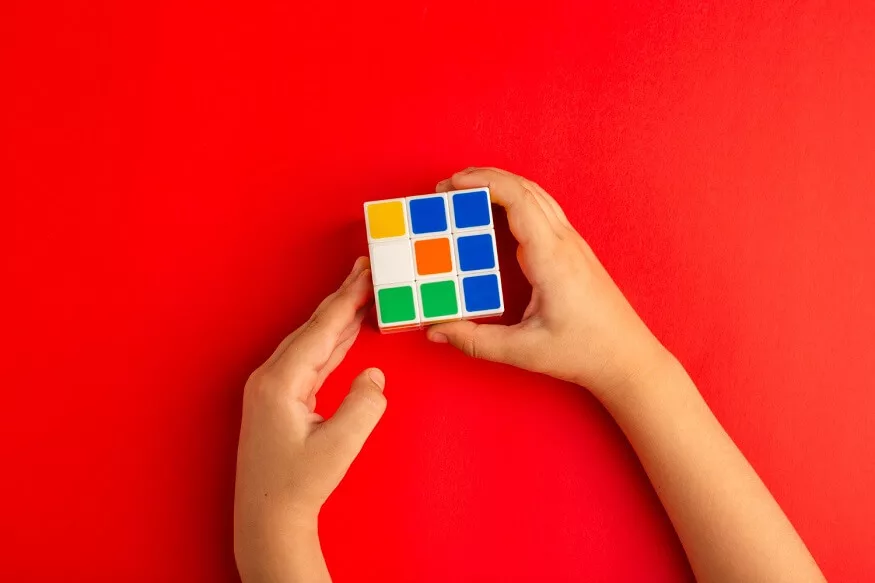“43,252,003,274,489,856,000” that’s so long and you skipped it right? In short, we can say 43 quintillion. That’s the number of possible combinations of the Rubik’s Cube. We have no idea how big 43 quintillion is. Let’s do the maths, if you go through 1 Rubik’s combination every second, in a week you could reach 1 million combinations. For 1 billion combinations it would take 31 years. Then how many years for 43 quintillion, that is beyond imagination.
Despite the number of possible combinations, Rubik’s cube or Magic cube has only one solution. This means that, of all possible combinations, there is only one in which all of the colours on each of the six faces match up with no mismatched squares. This is because there is a set of guidelines and restrictions about how the squares can be rotated and moved in Rubik’s Cube. It determines the puzzle’s solution.
Erno Rubik, a Hungarian sculptor and academic, created the Cube in 1974 to help his architecture students understand three-dimensional geometry. Since its invention, Rubik’s cube has become one of the most sold toys worldwide.
Also read : Maths Puzzles for Grade 2
Steps to solve Rubik’s Cube:
Rubik’s cube is so popular that many books were written on the topic of how to solve a Rubik’s cube or to learn Rubik’s cube. For example, a book by James J Norse called “The Simple Solution to Rubik’s Cube” sold over 6 million copies. The below-listed steps are our answer to the question of how to solve a Rubik’s cube for kids.
Step 1: Understanding the Rubik’s Cube:
The Rubik’s Cube has six faces, each labelled with a letter, that are given below. There are nine smaller cubes for one face. In total 54 smaller cubes can be rotated clockwise or counter clockwise. The movements of smaller cubes can be explained by notations.
U (up)- Top face of cube rotated clockwise by 90 degrees
D (down)- Bottom face rotated clockwise by 90 degrees
L (left)- Left face rotated clockwise by 90 degrees
R (right)- Right face rotated clockwise by 90 degrees
F (front)- Front face rotated clockwise by 90 degrees
B (back)- Back face rotated clockwise by 90 degrees
A letter followed by an apostrophe, U’, D’, L’, R’, F’, B’ means to turn that face counter clockwise by 90 degrees.
Any letter followed by the number 2 indicates doing the move twice. (For example, U2 means to rotate the top face 180 degrees).
Also read : What are the different lines in Math?
Step 2: Start with the Edges:
It’s better to start with the edges while solving the Rubik’s Cube. Look for any two edge pieces that have the same colour and position them close to one other. Then, rotate the bottom layer until the edge pieces are in their proper places. Repeat for the last four edges on the bottom layer.
Step 3: Solve the Bottom Layer:
After solving all four edges on the bottom layer, solve the remaining pieces on that layer. Look for a corner piece that has the same colour as the bottom layer’s centrepiece. Move this corner piece to the bottom layer, precisely below where it has to be. Then, rotate the bottom layer until the corner piece is in place. Repeat for the remaining four corner pieces on the bottom layer.
Step 4: Solve the Middle Layer:
After finishing the bottom layer, move on to the middle layer. Look for an edge piece on the top layer that needs to be moved to the middle layer. Move this piece to the top of the required side, then rotate the entire cube so that it is above the empty slot on the middle layer. Place the edge piece in its proper position by moving the middle layer. Repeat this for the remaining four edge pieces on the middle layer.
Step 5: Solve the Top Layer:
Finally, the top layer must be solved. This is the most challenging one in solving the Rubik’s Cube. Look for a top-layer corner piece that is in the correct position but not in the correct orientation. Rotate the top layer until the corner piece is in the cube’s top-right corner. Then, use the R U R’ U’ method to rotate the corner piece into its proper place.
Step 6: Finishing the Cube:
Once you have solved one corner piece, move on to the next until all four corners are in their proper places. If you have two corners in the correct position but not in the correct orientation, rotate the top layer until they are in the top right corner of the cube. Then perform the R U R’ U’ method until they are in the correct orientation. Repeat this process until all four corners have been resolved.
Fastest Way to Solve a Rubik’s Cube:
Speed cubing competitions are getting popular among kids nowadays, it means solving the Rubik’s cube as quickly as possible by using algorithms and strategies. Yusheng Du from China holds the record for the fastest time to solve a 3×3 Rubik’s Cube, finishing it in just 3.47 seconds.
The CFOP method is the fastest method for solving a Rubik’s Cube. It requires solving the cube in four steps:
The Cross
The First Two Layers (F2L)
The Orientation of the Last Layer (OLL)
The Permutation of the Last Layer.
Also read : Tips to Solve Maths Puzzles for Class 4 Students
Benefits of Rubik’s Cube:
Erno Rubik, the inventor of the magic cube, said that when he completed the cube for the first time in 1974, it gave him a great sense of accomplishment and utter relief. Hence teaching a kid how to solve a Rubik’s cube will improve his self-confidence and give him a sense of accomplishment. Additionally, it will help kids focus better and reduce stress.
Rubik’s cube has become a cultural icon, the symbol of intelligence. In a few movies, you could see the protagonists using Rubik’s Cube to show off their smartness. Learning how to solve a Rubik’s cube can help you to impress your friends in school easily.
Rubik’s cube is not only a fun activity, but it also develops the memory, problem-solving abilities, and analytical skills of young minds.
Conclusion:
In EuroSchool we believe that it’s not about solving the puzzle quickly or setting world records, it’s all about learning something new every time you get a Rubik’s cube in hand.
There are so many algorithms and strategies available to solve the Rubik’s cube, but using one’s skills and techniques can be an exciting and challenging activity for kids. We encourage our kids to learn Rubik’s Cube and also to participate in Rubik’s cube activities by creating extracurricular clubs, organising competitions, and implementing it into the curriculum.









